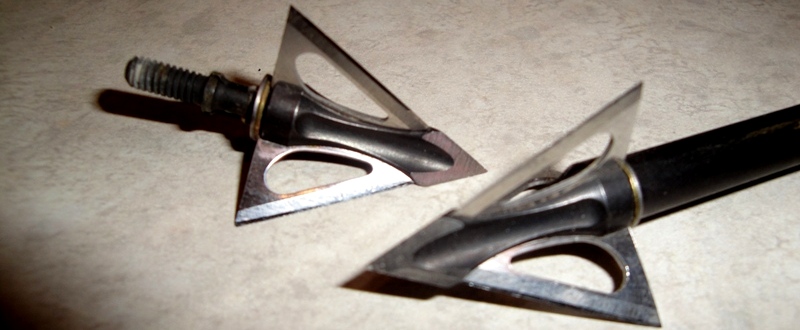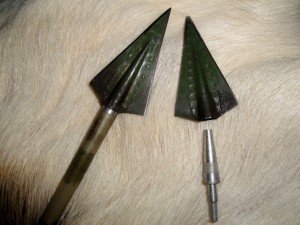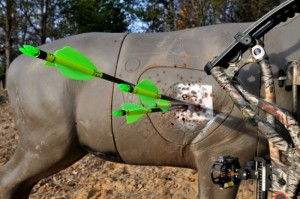Broadhead Confidence

As most hardcore archers would agree, there is something magical about the flight of an arrow. Whether from a traditional bow or a compound, it’s awesome how the arrow often appears to be on a string until impacting the point of aim. I have always been mesmerized by the flight of an arrow and amazed at how lethal a sharp broadhead on a well-placed arrow can be. Watching an arrow disappear in to the vitals of an animal is an amazing event. There is normally so much emotional and physical preparation to get to that moment in time, that it truly is an indescribable accomplishment. Yes, the flight of a well-tuned arrow can be a beautiful thing, while the cork-screwing flight of a broadhead-tipped arrow can be a daunting experience.
 It doesn’t seem like that long ago when I was gluing Zwickey broadheads to threaded adaptors so I could use them with aluminum arrows. I had taken several critters with my traditional bows and Zwickey-tipped wooden arrows, so I ended up spending a whole lot of energy building hunting arrows. Luckily, in those days time was not as hard to come by, as the process of putting together a half-dozen Zwickey-tipped arrows that grouped well, was more than time consuming. As time became more valuable and the faster arrow speeds magnified the inconsistencies, I gave up on my Zwickey dream and soon caught up to technology. This proved to be much more time efficient when transitioning from field points to broadheads for the upcoming seasons. I have used many different heads throughout the years and had good success with several. Some of the heads were more difficult to group with my field points, but by hunting season, I had always done what was needed to step into the woods with full confidence in my equipment and ability.
It doesn’t seem like that long ago when I was gluing Zwickey broadheads to threaded adaptors so I could use them with aluminum arrows. I had taken several critters with my traditional bows and Zwickey-tipped wooden arrows, so I ended up spending a whole lot of energy building hunting arrows. Luckily, in those days time was not as hard to come by, as the process of putting together a half-dozen Zwickey-tipped arrows that grouped well, was more than time consuming. As time became more valuable and the faster arrow speeds magnified the inconsistencies, I gave up on my Zwickey dream and soon caught up to technology. This proved to be much more time efficient when transitioning from field points to broadheads for the upcoming seasons. I have used many different heads throughout the years and had good success with several. Some of the heads were more difficult to group with my field points, but by hunting season, I had always done what was needed to step into the woods with full confidence in my equipment and ability.
As technology has evolved in all aspects of archery, it has become much easier to tune and consistently group arrows. The tolerances, micro-adjustable rests and sights, lower profile heads, etc. have been a blessing to us old school guys, and also nice for the beginner archer to quickly build confidence with accuracy…especially when setting up a hunting arrow.
The first step in taking an animal with a broadhead-tipped arrow is spending a whole lot of time shooting a properly fitted bow. Getting started with proper fit and shooting technique is a must, as changing bad shooting habits down the road is a challenge. Get to your local pro shop and do what it takes to shoot with good form. This goes for both beginner shooter as well as shooters who pull the bow out of the closet shortly before season. Like a pitcher on a mound, use your shooting sequence to build a consistent release and follow through. Once you feel like you are shooting with consistent form, the next step will be tuning your bow and tuning the flight of your arrow. If you haven’t done so, read Matt Brimmer’s last article, “Pre-Season Bow Setup”. Matt does a great job of explaining the techniques of putting together and maintaining a well-tuned bow.
 By mid-July, I want to be confident in my hunting set-up. Once your bow is tuned and you’re shooting field points consistently, it’s time to screw on the broadheads. There are several great designs out there. The most important aspect to me is that they hit where I’m aiming and stay together upon impact. My broadhead of choice as of the last few years is the 100gr G5 Striker. I tested five different broadheads after deciding to change and the G5 shot considerably better out of my setup than any of the others. I’m not saying the Striker is the best head, it was just the one that flew and grouped the best for me. I’ve shot it with the utmost confidence ever since. In my opinion, sometimes it’s better to change the broadhead to fit the bow, rather than change the bow to fit the broadhead. In many cases, a broadhead will consistently group with your field point if you have a well-tuned bow and arrow. Unfortunately, there are times they don’t. This can be very frustrating when your field points are shooting perfect holes through paper, yet the broadheads are a little off. This is very common so don’t let it bother you. This was the case with my latest bow.
By mid-July, I want to be confident in my hunting set-up. Once your bow is tuned and you’re shooting field points consistently, it’s time to screw on the broadheads. There are several great designs out there. The most important aspect to me is that they hit where I’m aiming and stay together upon impact. My broadhead of choice as of the last few years is the 100gr G5 Striker. I tested five different broadheads after deciding to change and the G5 shot considerably better out of my setup than any of the others. I’m not saying the Striker is the best head, it was just the one that flew and grouped the best for me. I’ve shot it with the utmost confidence ever since. In my opinion, sometimes it’s better to change the broadhead to fit the bow, rather than change the bow to fit the broadhead. In many cases, a broadhead will consistently group with your field point if you have a well-tuned bow and arrow. Unfortunately, there are times they don’t. This can be very frustrating when your field points are shooting perfect holes through paper, yet the broadheads are a little off. This is very common so don’t let it bother you. This was the case with my latest bow.
I had shot the Strikers out of three different bows and I never had a problem grouping with field points. For whatever reason, after tuning my new Matrix I consistently shot my broadheads three inches low at 30 yards. The bow had shown up just before season and I didn’t really have the time to get to “know” it. The technique I tend to use in that situation is I move my rest toward my field point group. To explain, my broadhead arrows were hitting lower than my field points so I moved my rest up slightly. After a few rest and cable adjustments my field points and broadheads were grouping together out to 80 yards. I hunted the whole season without readjusting and I took down six critters with six shots. My simple fix without frustration got me through the season. It can sometimes be as easy as a couple rest adjustments but can also take longer and include nock point, poundage, and even cable adjustments to obtain desired flight.
 The point I want to make it that it is very easy to get caught up in the technical side of broadhead tuning and, for that matter, most aspects of shooting a bow. This can be very frustrating. There are different techniques for everything. The problem with archery is that everyone shoots a bow differently, so what works for one setup does not always work for another. We need to have an open mind and have fun figuring out what works best for ourselves. The thing I see most important is the relationship between the archer and his/her bow. We, as archers, need to know the ins and outs of our bows and how they perform. When you arrive at that place, maintaining confidence becomes much easier. If you really want to take down that elk this season with your bow, then do what it takes to hit the hills with soaring confidence. Shoot the heck out of your bow and find “the” broadhead that works. Best of luck this year…elk season will be here before we know it. God Bless.
The point I want to make it that it is very easy to get caught up in the technical side of broadhead tuning and, for that matter, most aspects of shooting a bow. This can be very frustrating. There are different techniques for everything. The problem with archery is that everyone shoots a bow differently, so what works for one setup does not always work for another. We need to have an open mind and have fun figuring out what works best for ourselves. The thing I see most important is the relationship between the archer and his/her bow. We, as archers, need to know the ins and outs of our bows and how they perform. When you arrive at that place, maintaining confidence becomes much easier. If you really want to take down that elk this season with your bow, then do what it takes to hit the hills with soaring confidence. Shoot the heck out of your bow and find “the” broadhead that works. Best of luck this year…elk season will be here before we know it. God Bless.
